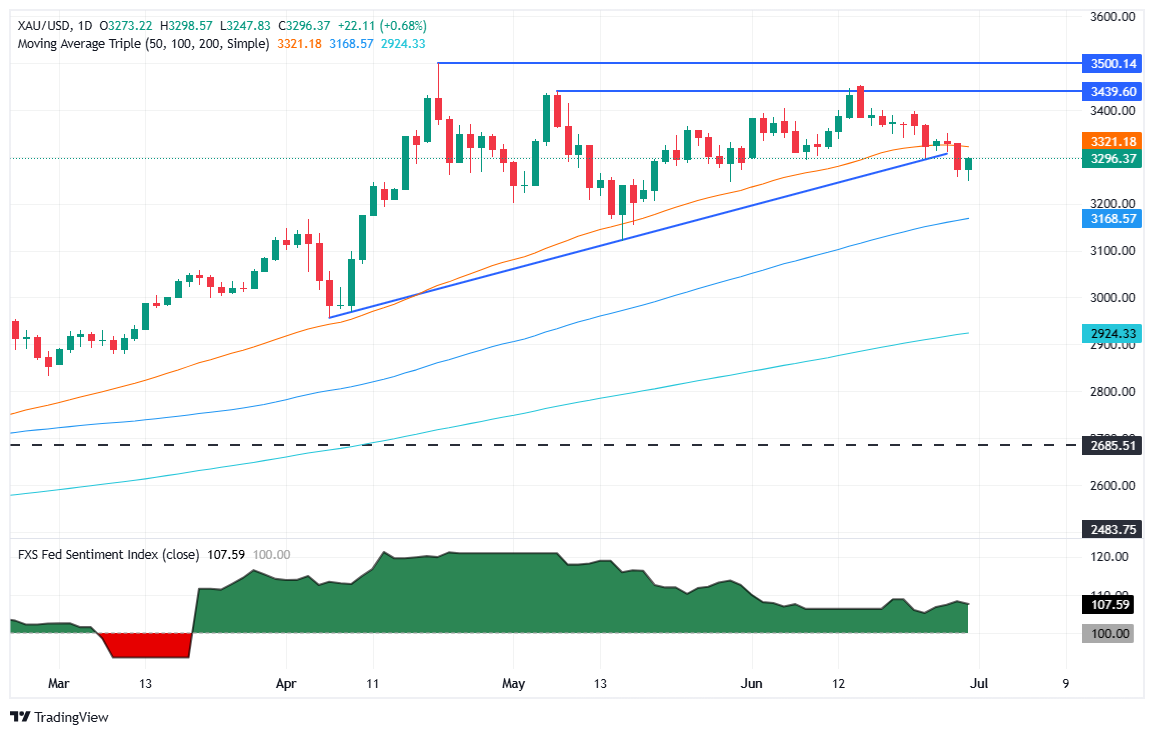Gold price rises on weaker US Dollar ahead of Nonfarm Payrolls week
- Gold bounces from $3,246 as the US Dollar nears February 2022 lows amid uncertainty over Fed leadership.
- Citi sees Gold consolidating between $3,100 and$3,500 in Q3; Middle East calm caps safe-haven flows.
- Bullion rose but remained capped by calm geopolitical risks.
- Traders brace for ISM, ADP, Jobless Claims and NFP in holiday-shortened week.
Gold (XAU) price advances modestly on Monday, up 0.58%, as the US Dollar (USD) extended its losses ahead of a busy economic calendar in the United States (US). Speculations that US President Donald Trump could pick the new Federal Reserve (Fed) Chair by September or October hurt the Greenback, which trades near February 2022 lows.
The XAU/USD pair trades at $3,292 after bouncing off daily lows of $3,246, poised to end June with gains of over 0.18%. Easing geopolitical tensions in the Middle East, along with the likely announcement of trade deals, capped Bullion’s advancement. Meanwhile, Citi revealed that Gold might consolidate within $3,100 - $3,500 an ounce in Q3.
The US Treasury Secretary, Scott Bessent, said that he is confident the “One Big Beautiful Bill” will progress in the coming hours. The legislation, which narrowly passed the Senate over the weekend, proposes a sweeping overhaul of the tax code, including broad deductions funded by cuts to Medicaid and green energy programs.
This shortened week, ahead of the US Independence Day on July 4, will feature ISM Manufacturing PMI data, ADP employment figures, Initial Jobless Claims, and the Nonfarm Payrolls report for June.
Daily digest market movers: Gold price climbs as US yields and US Dollar tumble
- XAU/USD is boosted by the decline in US Treasury yields, with the 10-year US Treasury note yielding 4.242%, a three-basis-point decrease. US real yields, which are calculated by subtracting inflation expectations from the nominal yield, are also down three basis points to 1.952%.
- Regarding trade, the US and China are resolving previous issues related to the rare earth minerals deal, and Canada has scrapped its digital services tax for US tech firms, contributing to an upbeat market sentiment that is putting a lid on Gold prices.
- Expectations that the Federal Reserve will ease policy by over 60 basis points (bps) in 2025, most likely underpinning Gold prices, which thrive in periods of lower interest rates and geopolitical uncertainty.
- Citi expects Gold prices to return to $2,500 - $2,700 by the second half of 2026.
- The approval of Trump's “One Big Beautiful Bill” is likely to increase the fiscal deficit by a substantial $3.8 trillion, which could further weaken the Dollar and boost the appetite for the precious metal.
- The ISM Manufacturing PMI for June is expected to improve from 48.5 to 48.8. Regarding employment data, the ADP Employment Change is projected to improve from 37K private jobs added to the workforce to 85K.
- Analysts estimate that June’s Nonfarm Payrolls figures will likely show the labor market is indeed cooling down, projected at 110K down from May’s 139K.
- Money markets suggest that traders are pricing in 63.5 basis points of easing toward the end of the year, according to Prime Market Terminal data.
XAU/USD technical outlook: Gold price set for a pullback to $3,200
Gold price is upward biased, but in the near term has shifted to neutral to slightly bearish. Once XAU/USD fell below the 50-day Simple Moving Average (SMA) of $3,322, it opened the door for a pullback, without it remaining far from testing the $3,200 mark.
The Relative Strength Index (RSI) has also turned bearish, indicating that bullish momentum has stalled.
However, if XAU/USD climbs past $3,300, buyers could challenge the 50-day SMA, followed by $3,350 and the $3,400 mark.

Gold FAQs
Gold has played a key role in human’s history as it has been widely used as a store of value and medium of exchange. Currently, apart from its shine and usage for jewelry, the precious metal is widely seen as a safe-haven asset, meaning that it is considered a good investment during turbulent times. Gold is also widely seen as a hedge against inflation and against depreciating currencies as it doesn’t rely on any specific issuer or government.
Central banks are the biggest Gold holders. In their aim to support their currencies in turbulent times, central banks tend to diversify their reserves and buy Gold to improve the perceived strength of the economy and the currency. High Gold reserves can be a source of trust for a country’s solvency. Central banks added 1,136 tonnes of Gold worth around $70 billion to their reserves in 2022, according to data from the World Gold Council. This is the highest yearly purchase since records began. Central banks from emerging economies such as China, India and Turkey are quickly increasing their Gold reserves.
Gold has an inverse correlation with the US Dollar and US Treasuries, which are both major reserve and safe-haven assets. When the Dollar depreciates, Gold tends to rise, enabling investors and central banks to diversify their assets in turbulent times. Gold is also inversely correlated with risk assets. A rally in the stock market tends to weaken Gold price, while sell-offs in riskier markets tend to favor the precious metal.
The price can move due to a wide range of factors. Geopolitical instability or fears of a deep recession can quickly make Gold price escalate due to its safe-haven status. As a yield-less asset, Gold tends to rise with lower interest rates, while higher cost of money usually weighs down on the yellow metal. Still, most moves depend on how the US Dollar (USD) behaves as the asset is priced in dollars (XAU/USD). A strong Dollar tends to keep the price of Gold controlled, whereas a weaker Dollar is likely to push Gold prices up.

